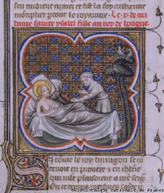 WEMSK15:Biblical Commentaries
WEMSK15:Biblical Commentaries
 WEMSK15:Biblical Commentaries
WEMSK15:Biblical Commentaries
WEMSK15
Biblical Commentaries
Your best guide here is Kaske, Chapter 1, "Biblical Exegesis," an
area in which he was the leader. Note that commentaries are often
useful for various topoi, not just for comment on a particular
passage, so that, if you have electronic access, it is often best
to search a key-word.
1. My first port of call for commentary is Cornelius a Lapide,
Commentaria in Sacram Scripturam. 21 vols. + 3 supplement volumes
(Paris: Vives, 1876-74). Bellarmin's Psalm commentary is added as
vols. 22-23, Balthasar Corder on Job is included, and J. M. Peronne
has added a two-volume index. There are numerous editions, and even
an English translation of the NT parts.
2. It is well to consult the indices in Migne. I downloaded these
from PL 219, 101-122 and put them on my hard disk. Of course,
you
need to consult the standard patristic bibliographies, as well as
Eligius Dekkers & Aemilius Gaar, Clavis patrum latinorum, 3d ed.
Sacris erudiri 3 (Steenbrugis: In Abbatia Sancti Petri, 1995);
Robert E. McNally, The Bible in the Early Middle Ages, Woodstock
Papers 4 (Westminster, MD: Newman, 1959), lists on pp. 89-117 the
commentaries from 650-1000; C. Spicq, Esquisse d'une histoire de
l'exegese latine, Bibliotheque Thomiste 26 (Paris: Vrin, 1944),
lists on pp. 395-401 commentaries from the eighth through the
fourteenth; Friedrich Stegmueller, Repertorium biblicum medii aevi,
11 vols. (Madrid: Consejo Superior de Investigaciones Cientificas,
Inst. Francisco Suarez, 1950-80). With these, you will have a list
of commentaries. If you have PL or the Cetedoc CD-ROMs available
electronically, you can search these in any number of ways; both
have good up-front engines, though I am opposed to up-front
engines.
3. In using the Glossa Ordinaria, our next port of call, you have
to be careful of the Migne edition (PL 113-114, under the works of
Walafrid Strabo); it is quite fragmentary and misses a lot, so you
are directed to the incunabula for serious work. On the Glossa
in
general, see Beryl Smalley, The Study of the Bible in the Middle
Ages, 3d ed. (Oxford: OUP, 1983).
4. Another quite popular work was Peter Comestor, Historia
scholastica, available in PL 175.635-924. It would not hurt you
to
just read through it, picking up motifs and topoi.
5. Kaske likes Hugh of St. Cher, Opera omnia in universum Vetus et
Novum Testamentum, available in various printed editions; I do not
know of a recent edition, and I don't own it, so I cannot speak of
it. Kaske's recommendation ought to be enough.
6. Nicholas of Lyre, Postilla literalis in Vetus et Novum
Testamentum, along with his Postilla moralis ... Printed many
times, but not recently. This is the commentary Luther used.
It is
often bound with the Glossa.
7. One of the best ways to approach the commentaries on the Gospels
is through the Catena aurea of St. Thomas, and perhaps the best way
to approach the Catena aurea is through The Sunday Sermons of the
Great Fathers. Patristic Homilies on the Gospels, transl. M. F.
Toal, 4 vols. (Chicago: Regnery, 1955-). This is a translation
of
the Catena aurea, but each reference is expanded to include the
full quotation. The Catena aurea is available on CD-ROM in Father
Busa's Thomae Aquinatis Opera Omnia (Milan: Editoria Elettronica
Editel, 1992); the text is that of Marietti edition (1953). There
is an English translation: Catena Aurea. Commentary on the Four
Gospels collected out of the Works of the Fathers by S. Thomas
Aquinas, new edition, 4 vols. (Oxford: James Parker, 1874). I
have
a fine old German translation: Des heiligen Thomas von Aquin, des
englischen Lehrers goldene Kette, transl. Joh. Nepomuk Dischinger,
4 vols., new edition (Regensburg: Manz, 1846-49).
8. Many of the standard commentaries on individual books are found
in PL: Ambrose on Luke, Augustine on Genesis and John, Gregory's
Moralia in Hiob, Bernard on the Song of Songs, etc. etc., and most
of these are available in English translation in The Ante and Post-
Nicene Fathers, which is also available online from The Christian
Classics Ethereal Library, now at Calvin:
http://www.ccel.org/fathers2/. There is an English translation of
Gregory's Morals: Morals on the Book of Job. Library of the Fathers
of the Holy Catholic Church 18, 21, 23, 31 (Oxford, 1844-50).
If
you do not own this, it would not be bad to xerox off the index,
though the Migne indices are good. The Corpus edition has a useful
index of scriptural references.
9. Peter Riga. Aurora Petri Rigae, Biblia versificata. A Verse
Commentary on the Bible, ed. Paul Beichner, 2 vols. Publications in
Medieval Studies 19 (Notre Dame, 1965). This is what it says
it
is, a versified Bible commentary, containing a good deal of the
Bible. It is pleasant to read, but not compendious; I have used it
as a text for a course. It should be read through, not consulted;
if you can get a reading group together, you could do a motif-
index. It had a good deal of influence also.
10. It is good not to forget those commentaries which have been
forgotten. Pseudo-Chrysostom's Opus imperfectum in Matthaeum (PG
56.611-946) has given us a number of motifs and was often cited in
the Middle Ages. It has even left its mark in the far north (see
Marchand on the Sika Stone).
11. Not a commentary, but a good source (look at the index) for
biblical motifs: David Lyle Jeffrey, ed., A Dictionary of Biblical
Tradition in English Literature (Grand Rapids: Eerdmans, 1992).
Signed articles, bibliography, examples.
12. You won't often need a modern commentary, but if you do, the
Anchor Bible is probably where you should go: The Anchor Bible, 1-
42 (Garden City, NY: Doubleday, 1964-). Be careful when reading
modern interpretations; modern man doesn't see things in the same
way medieval man did.